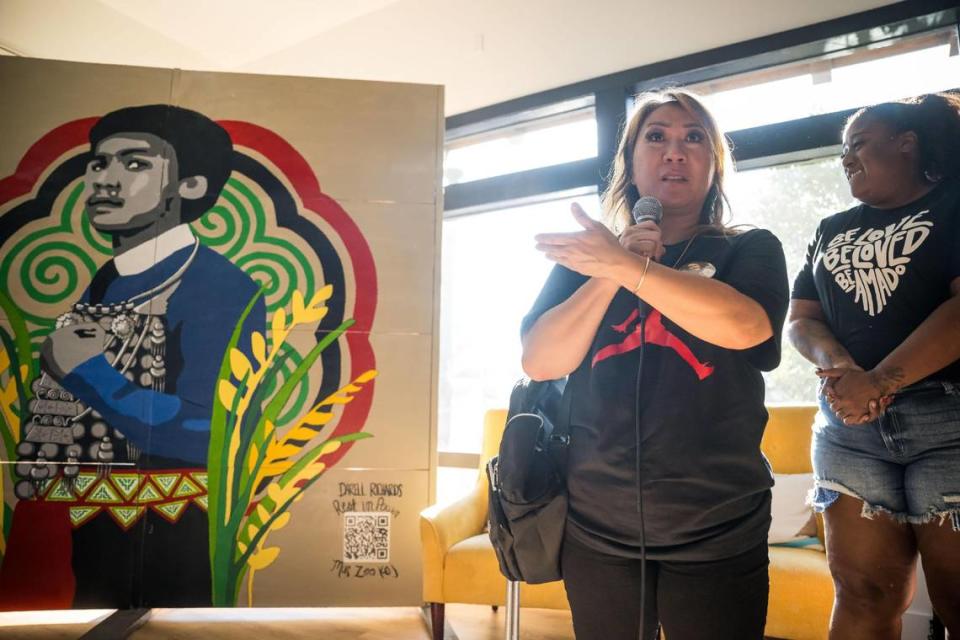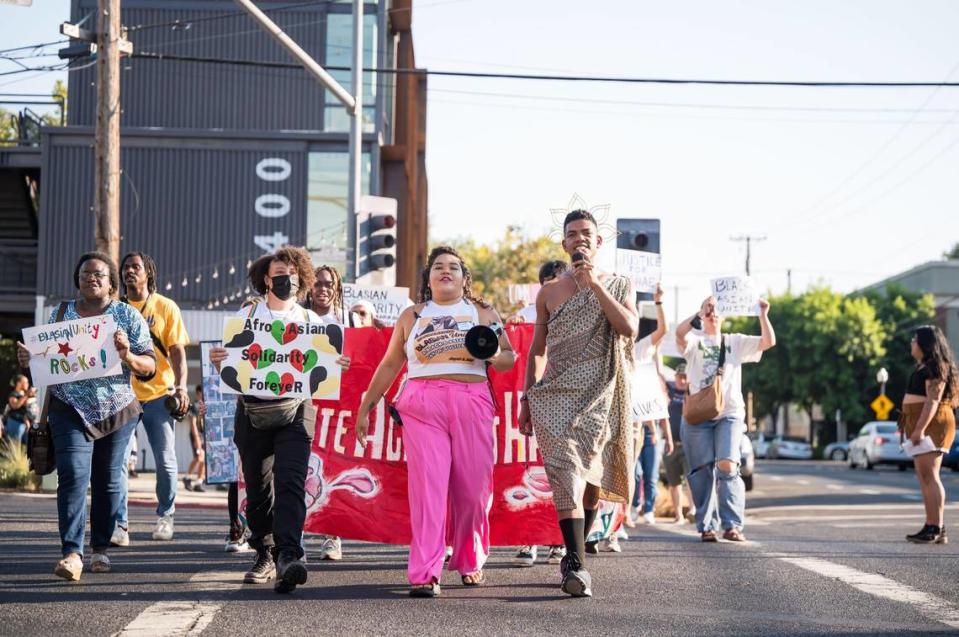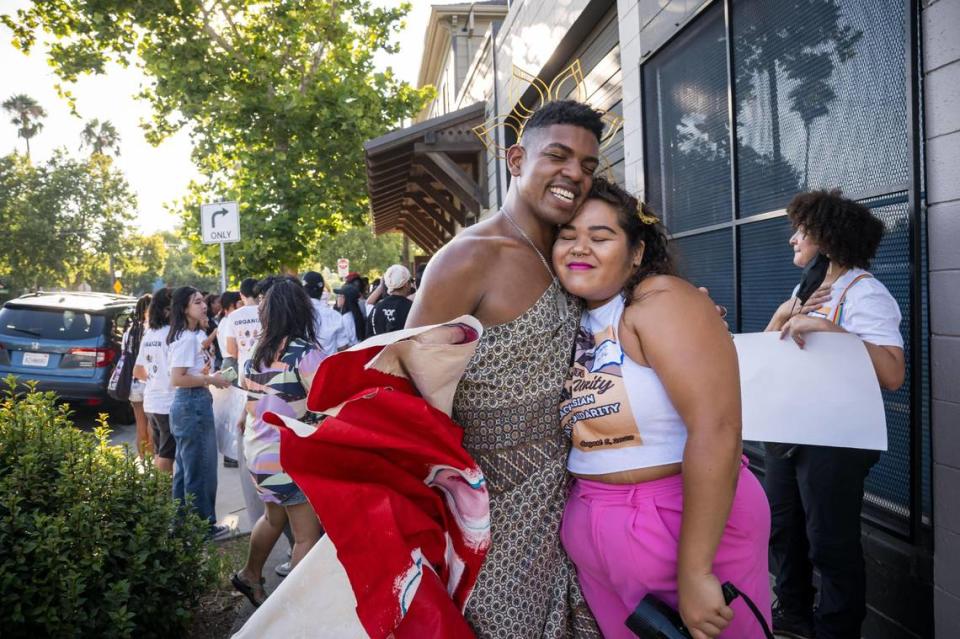First Blasian March in Sacramento’s Oak Park builds Black-Asian solidarity
- Oops!Something went wrong.Please try again later.
“Asian Lives for Black Lives!”
“Black Lives for Asian Lives!”
“Black Asian Power!”
“Black Asian Freedom!”
Business owners waved from doors and drivers honked from their cars as marchers — Black, Asian and multiracial — filled the historically Black neighborhood of Oak Park with their voices Saturday afternoon.
Over 120 people attended Sacramento’s first Blasian March, a solidarity-building event that began in New York City in 2020 and has also been held in Los Angeles and Chicago. With a book fair and speaker panel following the march, organizers pushed Black and Asian American community members at the event to confront barriers between the communities and ultimately recognize shared experiences to unite around.
The march also commemorated Darell Richards, a 19-year-old Black and Hmong Sacramentan shot and killed by Sacramento Police Department officers in 2018 while he was suffering a mental health episode. A federal police misconduct lawsuit filed by Richards’ family ended with a deadlocked jury last November.
Oak Park-based Black and Filipina artist Shawntay Gorman led the creation of a large mural portrait of Richards that was unveiled prior to the march, and marchers held signs with photos of Richards.

Founded by dancer and writer Rohan Zhou-Lee, who is Black and Filipinx and prefers the gender-neutral term, the Blasian March came to Sacramento after local Asian American organizers met Zhou-Lee at a conference in February.
Programming before and after the march was held at the office of All City Homes, a Black- and Asian-owned real estate agency.
Overcoming historical tensions to build solidarity
Activists from each community initially signaled their support for each other as anti-Asian hate and anti-Black police violence caught widespread attention in 2020. Long-term solidarity often struggled to materialize, however. Some Asian American activists embraced increased policing as a response to anti-Asian hate, for example, clashing with Black activists pushing to reduce policing to invest in community-based safety efforts.
Speakers at the event said that building solidarity required recognition both of the parallel experiences of Black and Asian American communities, and the tensions between them and the structural barriers that caused them.
While Black activists spoke out vocally against the incarceration of Japanese Americans in World War II, for example, Black people also settled in neighborhoods and homes vacated by the incarcerees due to housing covenants preventing both groups from living in white neighborhoods. Though Japanese and Black activists continued trying to build solidarity, the discrimination both groups suffered pitted them against each other after the war.
The 1992 Los Angeles riots resulted in disproportionate damage to businesses in Koreatown. Far from being the result of superficial prejudice, the targeting reflected Black anger that Koreans received preferential treatment compared to Black people from banks — from which Black people often struggled to get loans to start their own businesses — and from the police and criminal justice system, Gorman said.
Tension between the communities was especially high following an incident a year prior in which a Korean store owner shot and killed a 15-year-old Black girl named Latasha Harlins, but received only probation after being convicted.
The organizers of the Blasian March believed that these tensions, just like the individual forms of racial injustice each community faced, were ultimately caused by white supremacy. The conflicts could be overcome and unity found in combating discrimination if the communities worked to understand each others’ experiences, Zhou-Lee said.
The book fair and speaker panel parts of the event were meant to encourage the learning of these experiences to bridge Black Lives Matter and Stop Asian Hate movements, Lo said.

‘Exact same way they killed George Floyd’: Parallel experiences of Asian Americans ‘invisibilized’
While police violence against Black people has been highly visible, examples of police violence affecting Asian Americans are lesser known.
In December 2020, 30-year-old Filipino Navy Veteran Angelo Quinto died after Antioch police officers knelt on his back for five minutes after responding to a mental health call from his family.
Quinto died in the “exact same way they killed George Floyd,” Zhou-Lee said. Floyd was a Black man who died after a Minneapolis police officer knelt on his back for several minutes in May 2020.
Zhou-Lee also mentioned Christian Hall in the panel, a Chinese American teenager killed by Pennsylvania State Police in 2020 while his hands were up.
Historical parallels exist as well: As white mobs lynched thousands of Black people across America after the Civil War, hundreds of Chinese, Indian and Filipino immigrants were killed or driven from their homes and businesses across along the West Coast in racially motivated attacks.
Recognition of these shared experiences of violence would help Black and Asian American communities work together, but they are “invisibilized” by divisive narratives like depictions of Black people as the main perpetrators of anti-Asian crime, Zhou-Lee said. Around 75% of perpetrators of anti-Asian hate crimes are white.
‘Solidarity is our inheritance’
Though the event highlighted violence towards and conflict between Black and Asian communities, its overall tone was one of hope and celebration as panelists highlighted histories of and possibilities for successful solidarity.
“What we don’t talk about enough is the love, the care and the solidarity that got us through those horrendous moments,” said panelist Bobby Roy, a Filipino activist who works for the California Department of Education.
The field of Asian American studies, and even the label “Asian American,” were created in the Ethnic Studies and Third World Liberation Front movement of the 60s — a movement that built directly on earlier organizing by Black students and the Black-led Civil Rights and Black Power movements.
Within these movements there were many examples of Black and Asian community leaders building solidarity. The most well-known include Japanese American civil rights activist Yuri Kochiyama, who was known for her work with Malcolm X, and Chinese American activist Grace Lee Boggs, who spent her life fighting for tenants’ and workers’ rights in Black communities in Detroit.
When two white auto workers received light sentences after brutally killing Vincent Chin in 1982, blaming the Japanese auto industry for taking their jobs — not knowing that Chin was Chinese American — Black Southern Christian Leadership Conference leader Jesse Jackson vocally joined Asian American activists demanding justice.
“I want to remind you that solidarity is actually our inheritance,” Roy said. “This relationship between communities of color is also not new. We are not the first, we’re not the last.”
‘Get outside and touch people’: Panelists encourage concrete community work
Though sharing stories aids community building, it doesn’t “get anyone free,” panelist and educator Jordan McGowan said. McGowan urged attendees to directly combat market-driven disparities by working to get necessary services and resources to underprivileged communities.
Previously a history teacher at Rio Tierra Junior High School, McGowan is now the minister of programs at the K-8 independent Malcolm X Academy, which opened in 2022 in Oak Park. The school is run by a community organization called the Neighbor Program — modeled after the Black Panther Party — which also runs health and legal clinics, drawing inspiration from the Panthers’ community and social service initiatives.
“You gotta get outside and touch people,” McGowan said. “I heard a lot of great things (at this event), but I really hope … we see action. I hope we see people really move to be like, OK, that was dope, now let’s do something.”
Opportunities to take action were present at the event as various community organizations handed out fliers and other materials at tables around the room.
Inspired by McGowan and the Black Panthers, Celine Qin founded a youth collective called the Reclamation Project when she was 13, working with other high schoolers to organize supply drives and distribute food, school supplies and other items around the city. Now 16, Qin said that meeting McGowan at the Blasian March was a “full circle moment.”
For Sacramento Filipinix LGBTQIA+, one of the local groups that co-hosted the event, the march was one of a series of solidarity-building efforts.
The organization was responsible for organizing Elk Grove Pride this year, which fell on the weekend of Juneteenth. Mindful of the opportunity to uplift Black community members, Sac Filipinx worked with Black Womxn United to bring out Black artists and small businesses to the event, and design educational programming that centered Black queer and trans people.
Gorman was known for her involvement in the hip-hop scene and pop art portraits, including a portrait of Stephon Clark, a Black Sacramentan shot and killed by Sacramento police officers in his grandmother’s backyard in 2018.
But only in the past 10 months has she been more active in the Asian community, she said. The Blasian March was a space where external barriers between Black and Asian communities are “(taken) away for a little bit,” allowing members of the two communities to share their joy and pain freely — and a rare opportunity for Gorman to fully embrace her identity.
“To see Black and Asian people come together for this event is just beautiful,” she said. “It’s always been something that I wanted to do – helping organize this, doing the mural and being part of the panel, I feel like I was able to bridge both parts of my ethnicities. I hope to continue to be able to … change the visual landscape of my community through my art and be the bridge between both races.”


